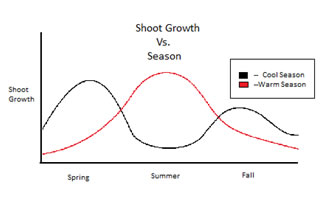Types of Grasses
Home | Job Outlook | Types of Grasses | Turf Striping
Transition Zone:
The transition zone in the U.S. is made up of the central mid-west and central eastern states. It is difficult to manage turf in the transition zone and does not have a specific grass type to manage.(Christians) The problem with the latitude of the transition zone is that it is too cool in the winter to manage warm-season grasses and to hot in the summer for cool-season grasses.(Christians) The strategy used to maintain a playable surface in the transition zone is to overseed in the winter. Overseeding consists of growing a cool-season annual grass in the winter while the warm-season grasses are dormant. According to Nick Christians, Perennial ryegrass and rough bluegrass are common cool-season grasses used in overseeding.
Warm-Season Grasses:
Warm-season grasses are used primarily in the southern United States. Common warm-season grasses include Bermudagrass, Zoysiagrass, St. Augustinegrass, and Buffalograss.(Zuk) Bermudagrass is by far the most popular warm-season grass. Warm-season grasses are known as C4 Plants. This is because they use the four-carbon compound called PEP carboxylase in photosynthesis. In grasses PEP carboxylase is a photosynthetic enzyme that can “attract” CO2 more efficiently than C3 plants, and allows the stomates of the plant to be closed more often.(Zuk) Having the stomates closed more often makes the plant more drought resistant which allows it to grow in the southern U.S. where there are higher temperatures.

Cool-Season Grasses:
Cool-season grasses are used primarily in the northern and north-western states. Common cool-season grasses are Kentucky Bluegrass, Bentgrass, Perennial Ryegrass, Tall Fescue, and Fine Fescue.(Zuk) The most popular cool-season grass is Kentucky Bluegrass, and is used as the primary turf on many sports complexes including the Twins new stadium Target Field. Whereas warm-season grasses are considered C4 plants cool-season grasses are C3 plants. Cool-season grasses use a three-carbon compound as opposed to a four-carbon compound.(Christians) Rubisco is the three carbon compound that cool-season grasses use in photosynthesis. Rubisco is more “attracted” to oxygen than CO2 and therefore has to keep is stomates open more often than C4 plant.(Zuk) In turn cool-season grasses are less drought tolerant because they lose water through their open stomates.